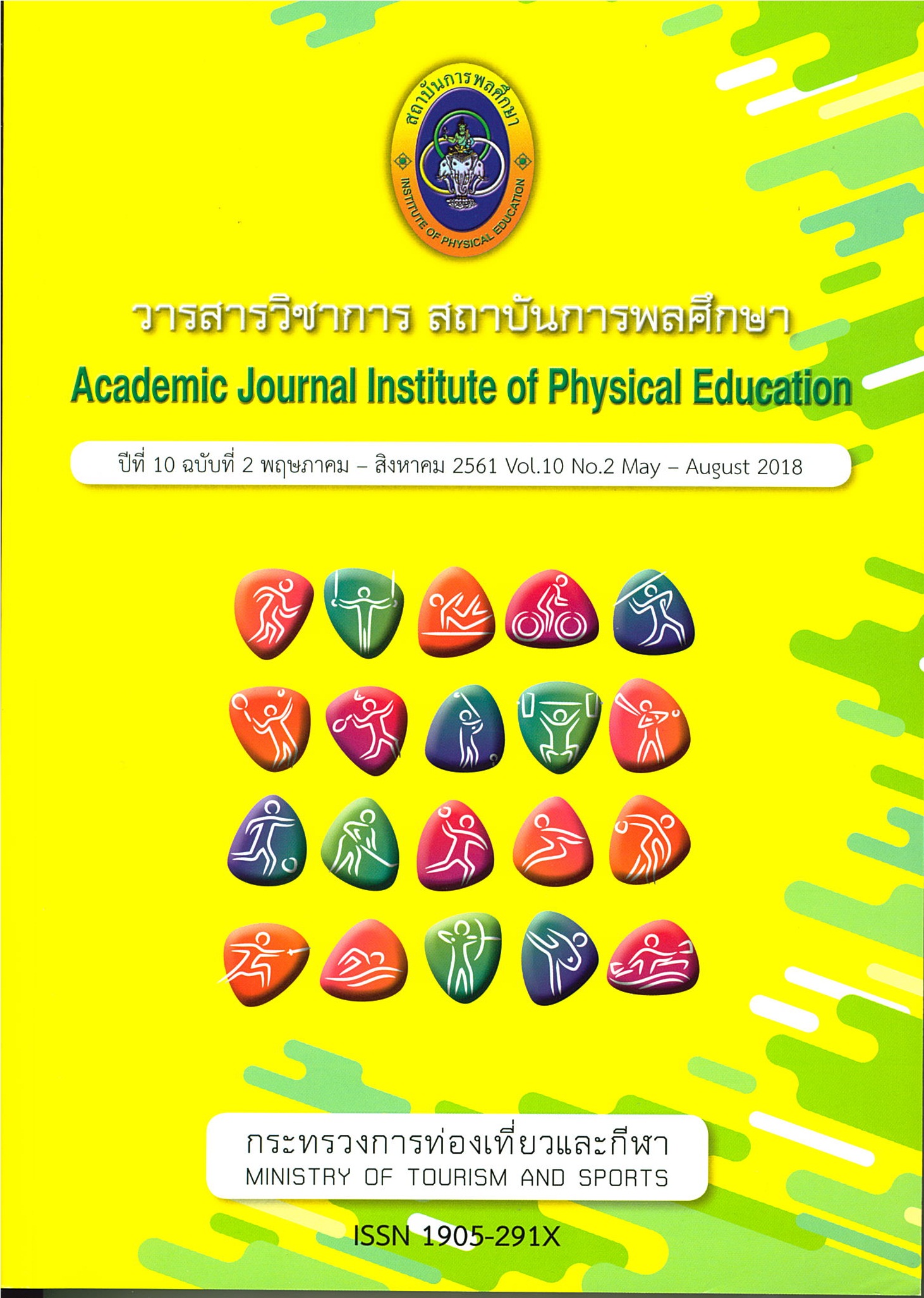The Effect of Pneumatic Resistance Weight Training on 50-Meter Crawl Swimming Speed
Main Article Content
Abstract
The purposes of this research were to examine the effect of pneumatic resistance weight training on 50-meter crawl swimming speed and to compare the effect of pneumatic resistance training and weight stack training on 50-meter crawl swimming speed. The populations were male sophomore students from the Institute of Physical Education, Suphanburi Campus. The selection criteria were male sophomore students who have completed swimming skills and teaching course and passed 50-meter crawl stroke swimming pre-test. Thirty subjects were purposively random sampled from swimming speed rank equally into two groups with equal abilities and randomly assigned into experimental and control group. Both groups were trained with the same swimming program for three days a week (Monday, Wednesday and Friday). The experimental group underwent pneumatic resistance training program whereas the control group underwent weight stack training program twice a week (Tuesday and Thursday). Both groups were test 50 meters crawl swimming speed after three weeks and after six weeks of training program. The data were
analyzed interms of means, standard deviations,one-way analysis of variance with repeated measures, multiple comparisons by Bonferroni method and means difference comparison by independent t-test at 0.05 level of significance.
The results were as the following:
1. When comparing means difference of time taken in 50-meter crawl stroke swimming within each group after 3-week and 6-week training, between after 6-week training and before training, between after 3-week training and before training. The results were significantly different at 0.05 level.
2. When comparing means difference of time taken of 50-meter crawl stroke swimming between both groups in each period (before training, after 3-week training and after 6-week of training) there were not significant differences at 0.05 level.
3. The percentage of speed development of the experimental group was 0.96 percent and 1.83 percent and the percentage of speed development of the control group was 0.25 percent and 0.41 percent after 3-week and 6-week training respectively.
In conclusion; the swim training program and weight training program could increase swimming speed of 50-meter crawl stroke swimmers. And pneumatic weight training was more efficient than weight stack training over extended training period, preferable longer than 6 weeks of training program.
Article Details
The published article is a copyright of the Academic Journal of Thailand National Sports University. The passage appeared in each article in this academic journal is a perspective of each author which is not related to the journal. Each author is required to be responsible for all components of his/her own article. If there are any mistakes, each author must be responsible for those mistakes on his/her own.
References
กฤตมุข หล่าบรรเทา. (2554). การเปรียบเทียบผลการฝึกด้วยเครื่องออกกำลังกายแบบฟรีเวทที่ใช้แรงต้านจากแรงอัดอากาศผสมกับแรงต้านด้วยน้ำหนักในสัดส่วนที่แตกต่างกันต่อความแข็งแรงและพลังกล้ามเนื้อ. (วิทยานิพนธ์ปริญญามหาบัณฑิตสาขาวิทยาศาสตร์การกีฬา).คณะวิทยาศาสตร์การกีฬา จุฬาลงกรณ์มหาวิทยาลัย, กรุงเทพมหานคร.
คณะกรรมการพัฒนาเศรษฐกิจและสังคมแห่งชาติ, สำนักงาน. (2555). แผนพัฒนาเศรษฐกิจและสังคมแห่งชาติ ฉบับที่ 11 (พ.ศ. 2555–2559). (ออนไลน์). สืบค้นเมื่อ 20 สิงหาคม 2557. จาก http://www.nesdb.go.th/Portals10/news/Plan/P11.pdf
ถนอมวงศ์กฤษณ์เพ็ขร์และสิทธา พงษ์พิบูลย์. (2554). สรีรวิทยาการออกกำลังกาย. กรุงเทพฯ: ตีรณสาร จำกัด.
พลากร นัคราบัณฑิต. (2553). ผลของการฝึกความมั่นคงของลำตัวที่มีต่อความแข็งแรงของกล้ามเนื้อหลังส่วนล่างและความสามารถในการว่ายน้ำท่าครอว์ลในนักกีฬาว่ายน้ำเยาวชนชาย. (วิทยานิพนธ์ปริญญามหาบัณฑิตสาขาวิทยาศาสตร์การกีฬา). คณะวิทยาศาสตร์การกีฬาจุฬาลงกรณ์มหาวิทยาลัย, กรุงเทพมหานคร.
พิสิษฐ์ธิติเลิศเดชา. (2545). ผลของการฝึกกำลังกล้ามเนื้อลำตัวแบบการหดตัวคงที่ต่อความเร็วในการว่ายน้ำท่าครอว์ลระยะทาง 50 เมตร. (วิทยานิพนธ์ปริญญามหาบัณฑิต หลักสูตรเวชศาสตร์การกีฬา). คณะแพทยศาสตร์จุฬาลงกรณ์มหาวิทยาลัย, กรุงเทพมหานคร.
ศุกล อริยสัจสี่สกุล. (2552). การนำหลักวิทยาศาสตร์การกีฬาเพื่อพัฒนากีฬาว่ายน้ำ. วิทยาศาสตร์การกีฬาและสุขภาพ, 10(1), 79.
ศุกล อริยสัจสี่สกุล. (2556). ว่ายน้ำ กีฬาเพื่อทุกคน. กรุงเทพฯ: สำนักพิมพ์แห่งจุฬาลงกรณ์มหาวิทยาลัย.
สนธยา สีละมาด. (2555). หลักการฝึกกีฬาสำหรับผู้ฝึกสอนกีฬา. กรุงเทพฯ: สำนักพิมพ์แห่งจุฬาลงกรณ์มหาวิทยาลัย.
สุทธิดาเจริญผล. (2554). ผลของการฝึกพลัยโอเมตริกบนบกและในน้ำที่มีต่อพลังระเบิดของกล้ามเนื้อขาและความเร็วในการว่ายน้ำท่ากบระยะทาง 50 เมตร ของนักกีฬาว่ายน้ำชาย. (วิทยานิพนธ์ปริญญามหาบัณฑิต สาขาวิทยาศาสตร์การกีฬา). คณะวิทยาศาสตร์การกีฬา จุฬาลงกรณ์มหาวิทยาลัย, กรุงเทพมหานคร.
Baker, D., Nance, S. & Moore, M. (2001). The load that maximizes the average mechanical power output during explosive bench press throws in highly trained athletes. Journal of Strength and Conditioning Research. 15(1), 20–41.
Blanch, P. (2010). The Swimming Machine. Journal of Sports Science and Technology. 10(1), 31-54.
Cissik, J. (2012). Strength and conditioning - A concise introduction. New York, NY: Routledge.
Frost, D. M., Cronin, J., & Newton, R. U. (2010). A Biomechanical Evaluation of Resistance - Fundamental Concepts for Training and Sports Performance. Sports Medicine, 40(4), 303–326. doi: 10.2165/11319420-000000000-00000
Jordan, S. (2013). Iron vs. Air: Why Pneumatic Resistance Might be the Next Big Thing. (Online). Available:http://greatist.com/fitnesspneumatic-resistance-exercise-machine. Retrieved April 30, 2016.
Kravitz, L. (2010). Resistance Training: Adaptations and Health Implications. Idea Today Health Publications. 2010; 14:38-46
Lander, J. E., Bates, B. T., Sawhill, J. A. & Hamill, J. (1985). A comparison between free weight and isokinetic bench pressing. Medicine and Science in Sports and Exercise. 17(3), 344–353.


